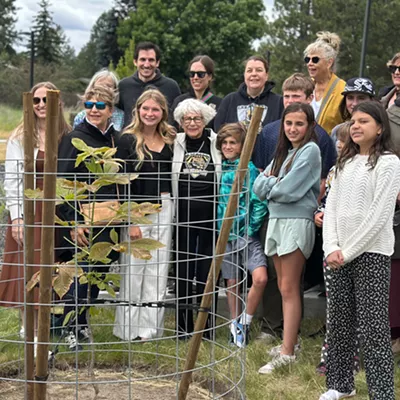Simple Hanging Baskets -- Flowers and vines spilling from suspended baskets, old wire colanders, farm buckets, wooden crates, bins, worn-out cowgirl boots, even old straw hats make a better presentation than the hanging baskets sold this time of year that marry gorgeous flowers with cheap green or white plastic containers. Walk around your place, inside and out, thinking "vessel," and you'll be surprised how many you'll find. Designing your own hanging baskets not only saves money, but also shows off your creativity. And not only do you end up recycling old items just lying around, but your hanging basket is mobile. Your moveable garden can be outside basking in the sun one day and then it can spend the weekend decorating your bathroom for out-of-town guests or that enjoyable lengthy Sunday bath.
Drainage -- Once you've found your container, think drainage. Plants don't like wet feet. If it's a bucket, think about drilling some holes in the bottom. Either way, you'll want to put a couple inches of gravel or broken pieces of clay pots in the bottom.
If you're using old boots or shoes, you'll need all the room you can get for soil, so drilling several holes in the sole is the way to go. Anything you find that is too porous (i.e., an old wire basket) to hold the soil can be fixed by adding a layer of conifer clippings or well-soaked moss. On top of the clippings, use plastic sheeting (like a grocery store bag) to retain water. Hold the plastic in place with clothes pins while you fill the basket with potting soil. With a pair of scissors, clip some holes in the sheeting. Natural clippings can also help disguise an ugly liner like an old felt hat.
Hanging Your Basket -- Doubled-up baling twine and colorful wide stout ribbon can be used to hang your basket. Tie a small twig or make a large knot in the end so it doesn't pull through the liner. If you're recycling last year's conventional hanging wire basket, the chains for hanging it will get in your way when you're planting. See if they'll come off with a pair of pliers before you plant. If you've chosen a bucket, remove the handle first.
Heavy-duty wire clothes hangers work great. Using a pair of wire clippers and pliers, make a four-pronged hanger by bending and shaping the wire.
The traditional way to hang baskets is from a bracket fixed to a wall or fence. Visit a hardware store to choose a design you like. Mounting instructions are usually included. If not, grab a knowledgeable clerk and tell them your medium ---- wood siding, brick wall, etc. They should be willing to help you.
If you're using a wicker basket that has a handle, buy or make a wire "S" hook.
Choosing Plants -- Fuchsias and ivy plugs are classic bedding plants that are widely available. Choose plants that have not yet started to flower. Look for healthy green plants with no yellowing. Check for signs of insects before you purchase them. The white discarded skins of aphids are easy to spot. White flies are tiny, white insects that fly up when you gently shake the foliage. If your outside flower beds have sprouted some volunteer pansies, these can be carefully dug up and used. Other plants that work well in hanging baskets are impatiens, primrose, begonia, silver dust, geranium, marigold, nasturtium, petunia and lobelia. Pay attention to whether plants prefer full sun or part sun/part shade.
Watering -- Never let your hanging basket dry out. It'll be difficult for it to wick water again and the water you add to save it might run right through without wetting all the soil. If this happens, set the bottom of your hanging basket in a bucket of water until the soil is wet again. It might take a while, so be patient. Every now and then, dust the leaves off with a shower of water using either a gentle-spray hose attachment or by setting it in the shower in your bathroom.
If you're leaving for a few days, it's best to take your hanging basket down and set it in the shade, where it's less likely to dry out. Otherwise, you'll need to find a plant-sitter to water for you.
Fertilizing -- Start with good quality potting soil. Black Gold, an all-organic potting soil with earthworm castings, is widely available in smaller nurseries. Visit a local nursery for fertilizer. They are more likely to have organic fertilizers like liquid kelp. Regular feeding will keep your creation vibrant, productive and healthy.
Trimming -- Faded blooms and spent leaves are easy to remove with a pair of small scissors. Well-tended baskets not only look good, but also flower longer.
Publication date: 06/05/03
















